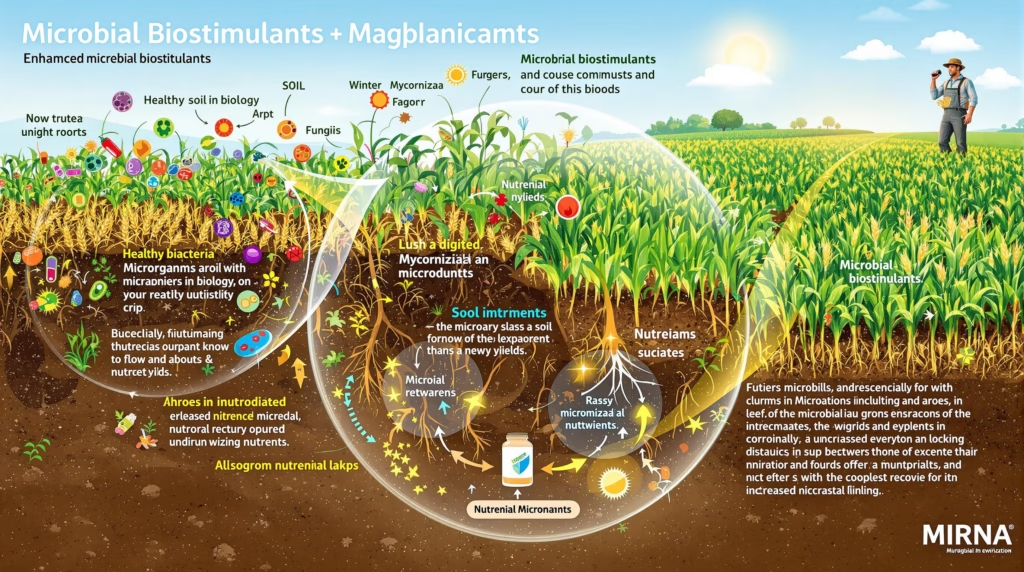Beyond Conventional Inputs: The Microbial Revolution
Agricultural productivity has traditionally relied on synthetic fertilizers and crop protection chemicals to maximize yields. However, this approach often overlooks the complex biological networks that naturally support plant growth. Microbial biostimulants—products containing beneficial bacteria, fungi, and their derivatives—represent a paradigm shift in crop management by enhancing plant performance through biological processes rather than direct nutrient provision or pest elimination. By stimulating natural soil-plant interactions, these innovative inputs improve nutrient efficiency, stress tolerance, and overall crop resilience while reducing environmental impacts associated with conventional agriculture.

The Diverse World of Beneficial Microorganisms
Microbial biostimulants encompass several functional groups that support plant health through distinct mechanisms:
- Plant Growth-Promoting Rhizobacteria (PGPR)
These specialized bacteria colonize the rhizosphere—the narrow zone surrounding plant roots—where they enhance growth through multiple pathways. Some produce phytohormones like auxins and cytokinins that stimulate root development and cell division. Others solubilize phosphorus and other nutrients, making previously unavailable soil resources accessible to plants. Genera like Bacillus, Pseudomonas, and Azospirillum demonstrate remarkable abilities to enhance crop performance across diverse environments. - Mycorrhizal Fungi
Forming symbiotic relationships with approximately 80% of terrestrial plants, these fungi extend the plant’s effective root system through extensive hyphal networks. Arbuscular mycorrhizal fungi penetrate root cells to exchange nutrients for plant-derived carbon, while ectomycorrhizal fungi create a protective sheath around roots. These ancient partnerships dramatically improve water and nutrient acquisition, particularly in challenging soil conditions. - Nitrogen-Fixing Microorganisms
Beyond the well-known Rhizobium bacteria that form nodules on legume roots, researchers have identified diverse microbes capable of biological nitrogen fixation. Free-living bacteria like Azotobacter and associative nitrogen fixers such as Gluconacetobacter can supplement plant nitrogen needs without forming visible structures, reducing dependency on synthetic fertilizers. - Endophytic Microorganisms
Living within plant tissues without causing disease, endophytes produce bioactive compounds that enhance plant metabolism, trigger defense mechanisms, and improve stress tolerance. These internal symbionts represent a frontier in biostimulant development, with potential applications in both conventional and organic production systems.
Mechanisms of Action and Agronomic Benefits
Microbial biostimulants influence crop performance through several complementary pathways:
- Enhanced Nutrient Acquisition and Efficiency
By solubilizing soil-bound nutrients, producing chelating compounds, and extending the plant’s exploration zone, beneficial microbes improve nutrient use efficiency. This allows for maintained or increased yields with reduced fertilizer inputs, addressing both economic and environmental concerns. - Abiotic Stress Mitigation
Certain microbial strains help plants withstand environmental stresses like drought, salinity, and temperature extremes. They accomplish this by regulating osmotic adjustment, producing protective compounds, and modifying root architecture to improve water acquisition during stress periods. - Induced Systemic Resistance
Many beneficial microbes prime plant defense systems without activating them fully—a phenomenon called induced systemic resistance. This “immunization” effect prepares plants to respond more quickly and effectively to pathogen attacks without the metabolic costs of continuous defense activation. - Soil Structure Improvement
Microbial activity produces polysaccharides and other compounds that bind soil particles into stable aggregates, enhancing water infiltration, aeration, and root penetration. This biological soil conditioning complements the direct plant-growth effects of biostimulants. - Phytohormone Modulation
Many beneficial microbes produce or influence plant hormones that regulate growth and development. This biological fine-tuning can enhance specific crop traits like flowering, fruiting, or root development depending on the microbial consortium applied.
Implementation Strategies and Considerations
Successful integration of microbial biostimulants requires thoughtful application approaches:
- Delivery Systems and Timing
Microbes can be applied as seed treatments, in-furrow applications, foliar sprays, or soil drenches. Each method offers advantages for specific crop systems and target microorganisms. Application timing often proves critical, with early establishment of beneficial populations generally yielding the greatest benefits. - Compatibility with Existing Practices
Some agricultural chemicals, particularly fungicides, may adversely affect beneficial fungi. Developing integrated programs that maintain microbial viability while addressing immediate crop protection needs requires careful planning and product selection. - Environmental Factors
Soil conditions—including pH, organic matter content, temperature, and moisture—significantly influence microbial establishment and activity. Understanding these interactions helps predict where and when specific biostimulants will provide optimal benefits. - Quality Control and Formulation
Maintaining microbial viability during production, storage, and application presents technical challenges. Advanced formulation technologies including encapsulation, specialized carriers, and osmoprotectants help deliver viable microorganisms to their target zones.
Research Frontiers and Future Directions
The field of microbial biostimulants continues to evolve rapidly:
- Microbiome Engineering
Moving beyond single-strain inoculants, researchers now design synthetic microbial communities with complementary functions. These designer consortia aim to establish stable, beneficial microbiomes that enhance multiple aspects of crop performance simultaneously. - Precision Microbials
Matching specific microbial strains to particular crop varieties, soil types, and environmental conditions increases effectiveness. Advanced screening techniques and field validation protocols help identify these optimal combinations. - Omics-Based Discovery
Genomics, proteomics, and metabolomics accelerate the identification of beneficial traits in soil microorganisms. These technologies enable researchers to select candidates with specific mechanisms of action tailored to address particular agronomic challenges. - Regulatory Frameworks
As the biostimulant sector expands, regulatory systems evolve to address these products’ unique characteristics. Developing appropriate efficacy testing, safety assessments, and quality standards remains crucial for market development.
Integrating Biostimulants into Sustainable Agriculture
Microbial biostimulants represent a crucial bridge between conventional and organic approaches, offering tools that enhance productivity while supporting ecological principles. By stimulating natural biological processes rather than replacing them, these products help restore soil health in degraded agricultural systems while maintaining yields. As agriculture faces mounting pressure to produce more food with fewer inputs and reduced environmental impact, microbial technologies offer a promising pathway toward systems that work with nature rather than against it. The microbial revolution in agriculture demonstrates that productivity and sustainability need not be competing goals—when properly harnessed, soil biology can deliver both.
References
- Rouphael, Y., & Colla, G. (2020). Editorial: Biostimulants in agriculture. Frontiers in Plant Science, 11, 40.
- Backer, R., Rokem, J. S., Ilangumaran, G., et al. (2018). Plant growth-promoting rhizobacteria: Context, mechanisms of action, and roadmap to commercialization of biostimulants for sustainable agriculture. Frontiers in Plant Science, 9, 1473.
- du Jardin, P. (2015). Plant biostimulants: Definition, concept, main categories and regulation. Scientia Horticulturae, 196, 3-14.
- Yakhin, O. I., Lubyanov, A. A., Yakhin, I. A., & Brown, P. H. (2017). Biostimulants in plant science: A global perspective. Frontiers in Plant Science, 7, 2049.
- Sessitsch, A., Pfaffenbichler, N., & Mitter, B. (2019). Microbiome applications from lab to field: Facing complexity. Trends in Plant Science, 24(3), 194-198.
For those seeking to understand more or even implement microbial solutions in their agriculture, explore Agri AI: Smart Farming Advisor

Leave a Reply